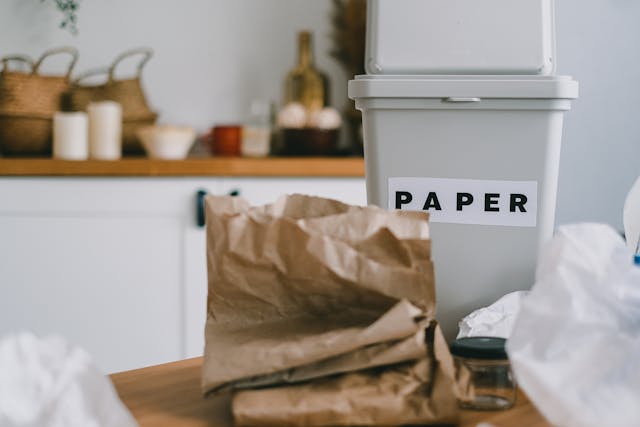Paper clutter at home is messy and it’s bad for the environment. Old mail, school papers and extra printouts pile up on tables and in drawers. These paper piles add to household waste and consume trees and water. People are focused on reducing plastic or saving energy but managing paper clutter is another way to be environmentally responsible.
Each sheet of paper requires materials, energy and water to produce. These resources are wasted when piles of unused paper sit around the home. Flyers, mail, receipts and paperwork arrive daily. Most of it is ignored or left unorganised instead of being recycled or stored with intention.
Many of these documents are never used and when they are thrown out they still require effort to recycle or end up as landfill waste. For households focused on sustainability, tackling everyday paper clutter is an easy win.
How Paper Clutter Hurts the Environment Beyond the Surface
Paper starts to affect the environment long before it reaches the home. Production begins with logging which if not managed well leads to forest loss. Once trees are cut the process moves to manufacturing where energy and water are used in large quantities.
Paper production also involves chemical treatments. Bleaching and printing introduces substances that can harm waterways and soil. When paper ends up in landfills, inks and dyes affect the environment long after disposal.
Another consideration is the carbon footprint of transporting paper products. Delivering paper from production facilities to homes uses fuel and emissions. Much of this paper becomes clutter, meaning resources were consumed without benefit. Switching to digital formats wherever possible helps to reduce this impact. Tools that let you convert to PDF make storing and managing documents more sustainable.
The Environmental Cost of Paper Storage at Home
Filing cabinets, storage bins and boxes full of paper are part of a household’s environmental footprint. Storing physical documents takes up space that could be used for something else. Homes with extra storage require more building materials and energy to maintain.
Keeping multiple copies of paperwork increases paper usage. When households hold onto multiple versions of the same document without reviewing them, they use more resources than needed. This means duplicate items are stored for years without purpose.
Products used to organize paper clutter like folders, trays and plastic containers have an environmental cost. Many of these are made from non-recyclable materials and when they are replaced or discarded they add to the waste stream.
Digital Storage is the Sustainable Way
Moving to digital storage reduces the need for paper. Converting household records to electronic files reduces overall paper usage and carbon footprint of printing, storing and recycling.
Digital storage uses less space and is more organized. Important documents like financial statements, contracts and user manuals can be stored in folders. Files can be searched by name or date, saving time and effort.
Choosing file formats like PDF means documents will keep their formatting and be readable across devices. Converting old paper records into PDFs helps households manage their data better.
Scanning paper documents is easy with smartphone apps. Most people can start this process today, no extra equipment or special skills needed. Scanning a few pages a day builds momentum and clears physical space over time.
Concerns About Going Paperless
Data safety is the main concern when it comes to online storage. Using strong passwords and 2 factor auth reduces risk and backing up files regularly prevents loss.
If you’re unsure about changing your system start with low risk categories like recipes, manuals or hobby materials. These are a good test of the digital system before moving on to sensitive info.
Some documents like legal certificates or contracts still need to be kept in their original form. These should be stored in a secure physical location with a record of where they are kept. Everything else can be scanned and stored digitally.
Going paperless can feel big but breaking it down into small sessions makes it easier. Focus on one folder, drawer or stack at a time. Keeping goals realistic avoids frustration and makes progress visible.
Sustainable Results That Last
Clearing paper clutter has lasting benefits. It keeps homes tidy, reduces waste and frees up space. More importantly it supports the responsible use of natural resources.
Going paperless doesn’t mean giving up access to important info. It means storing documents in a way that uses less materials and creates less waste. Every scanned page makes a small difference and these add up over time.
Having a digital system makes it easier to stay organised. Finding documents is quicker, less paper enters the home and less supplies are needed to keep things in order. It’s a simple manageable way to reduce your environmental impact without sacrificing convenience.
Take Action to Reduce Paper Waste at Home
Tackling paper clutter is a practical step to living more sustainably. Reducing, scanning and organising paper reduces waste and makes homes more efficient. Going digital reduces resource use and supports long term organisation. By paying attention to the paper we keep and adopting better habits we can reduce our impact and enjoy the benefits of a more streamlined filing system.




